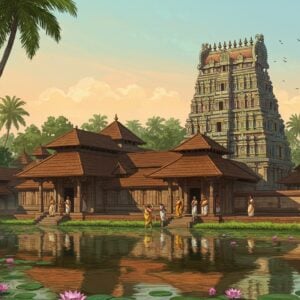
The Mahabharata, a monumental Sanskrit epic, stands as a cornerstone of Indian culture and philosophy. Alongside the Ramayana, it narrates a compelling tale of family conflict, duty, and righteousness, centered around the Kurukshetra War between the Pandavas and Kauravas. Composed by the sage Vyasa, the Mahabharata is structured into 18 books, known as Parvas, each brimming with intricate narratives, philosophical discourses, and profound teachings.
This comprehensive guide explores each of the 18 Parvas, offering insights into their significance and contribution to the epic’s overarching narrative. For those seeking to delve deeper into Indian tradition and culture, understanding the structure of the Mahabharata is essential.
Exploring the 18 Parvas
Each Parva within the Mahabharata plays a crucial role in developing the narrative, introducing characters, and exploring complex themes. Let’s embark on a journey through these literary divisions:
1. Adi Parva (The Book of the Beginning)
The Adi Parva lays the groundwork for the epic. It introduces the key players, traces the lineage of the Kuru dynasty, and sets the stage for the conflicts to come. Key elements include the birth of the Pandavas and Kauravas, the backstory of Bhishma, Devavrata’s pivotal vow, escalating tensions, and the marriage of Drona’s son, Ashwatthama. This Parva is fundamental in establishing the epic’s foundation.
2. Sabha Parva (The Book of the Assembly Hall)
The Sabha Parva centers around the magnificent assembly hall of Hastinapura, constructed by Maya, the Asura architect. This section highlights the infamous game of dice, where Yudhishthira loses his kingdom, his brothers, and even Draupadi. The themes of honor, deceit, and the devastating consequences of gambling are powerfully portrayed, foreshadowing the inevitable conflict.
3. Vana Parva (The Book of the Forest)
This Parva recounts the Pandavas’ twelve years of exile in the forest. It’s a period of introspection, learning, and encounters with various sages and mystical beings. Key elements include the teachings of Markandeya, the captivating story of Nala and Damayanti, and Arjuna’s arduous quest for divine weapons. The Vana Parva is rich in philosophical discourses and allegorical tales.
4. Virata Parva (The Book of Virata)
The Virata Parva describes the Pandavas’ thirteenth year of exile, spent incognito in the kingdom of Virata. They conceal their identities and assume various roles within the court. This Parva culminates in a battle between Virata’s forces and the Kauravas, during which Arjuna dramatically reveals his true identity.
5. Udyoga Parva (The Book of Effort)
Udyoga Parva details the intense preparations for the impending war. Diplomatic efforts are made to avert the conflict, including Krishna’s crucial mission to the Kaurava court. The themes of duty, righteousness, and the inevitability of war are emphasized, building tension and anticipation.
6. Bhishma Parva (The Book of Bhishma)
This Parva marks the beginning of the Kurukshetra War, with Bhishma leading the Kaurava army. It portrays Bhishma’s extraordinary prowess on the battlefield, Krishna’s guidance to Arjuna, and the strategic formations employed in the war. A pivotal moment is Krishna’s revelation of his divine form to Arjuna, the Bhagavad Gita, which is a core text of Hindu philosophy.
Poojn.in offers a wide selection of Krishna idols and pictures to help you connect with this divine figure and his teachings. We also offer incense sticks and other puja items to enhance your spiritual practice.
7. Drona Parva (The Book of Drona)
Following Bhishma’s fall, Drona takes command of the Kaurava army. This Parva witnesses the tragic death of Abhimanyu and depicts intense battle sequences. Drona’s own demise at the end of this Parva marks a significant turning point in the war.
8. Karna Parva (The Book of Karna)
This Parva focuses on Karna’s leadership of the Kaurava army. His valor, challenges, and the fierce combat between him and Arjuna are central to this section. Karna’s tragic death underscores themes of loyalty, friendship, and fate.
9. Shalya Parva (The Book of Shalya)
Shalya reluctantly leads the Kaurava army after Karna’s death. The deaths of key warriors and the decline of the Kaurava forces are depicted in this Parva. Shalya’s own death is a significant event in the war’s progression.
10. Sauptika Parva (The Book of the Sleeping Warriors)
This Parva describes Ashwatthama’s vengeful night raid on the Pandava camp, resulting in the massacre of sleeping warriors. This act raises complex moral questions about warfare and revenge.
11. Stri Parva (The Book of the Women)
The Stri Parva portrays the aftermath of the war, focusing on the grief and lamentations of the women who lost their loved ones. It powerfully illustrates the devastating emotional impact of war on society.
12. Shanti Parva (The Book of Peace)
This Parva centers on Bhishma’s teachings from his deathbed. He imparts profound wisdom on governance, duty, and the principles of dharma, offering guidance on righteous living and societal harmony. It is a philosophical treatise on leading a virtuous life.
13. Anushasana Parva (The Book of Instructions)
Bhishma’s teachings continue in this Parva, covering discourses on charity, ethics, and social responsibilities. It delves deeper into various aspects of dharma and provides a framework for ethical conduct.
14. Ashvamedhika Parva (The Book of the Horse Sacrifice)
This Parva narrates Yudhishthira’s performance of the Ashvamedha Yajna, a symbolic ritual signifying sovereignty and the consolidation of power. Arjuna’s adventures while guarding the sacrificial horse are also recounted.
15. Ashramavasika Parva (The Book of the Hermitage)
This Parva describes the later years of key characters, including Dhritarashtra, Gandhari, Kunti, and Vidura, who choose to live in the forest, renouncing worldly attachments. It explores themes of renunciation and the pursuit of spiritual goals.
16. Mausala Parva (The Book of the Clubs)
This Parva narrates the tragic end of the Yadava dynasty, including the deaths of Krishna and Balarama. It depicts internecine violence among the Yadavas, highlighting the transient nature of power and the destructive consequences of internal conflict.
17. Mahaprasthanika Parva (The Book of the Great Journey)
This Parva describes the Pandavas’ final journey, their renunciation of worldly possessions, and their symbolic ascent of Mount Himalaya. It represents their detachment from earthly concerns and their journey towards liberation.
18. Swargarohanika Parva (The Book of the Ascent to Heaven)
The concluding Parva of the Mahabharata narrates Yudhishthira’s ascension to heaven and his reunion with his brothers and Draupadi. It explores themes of redemption, the eternal nature of the soul, and the ultimate destination of the righteous.
Deepen your understanding of the Mahabharata and its profound teachings with Poojn.in’s collection of spiritual books and resources. Explore our range of articles and blog posts covering various aspects of Indian culture and spirituality.


